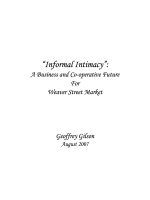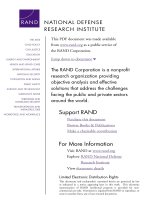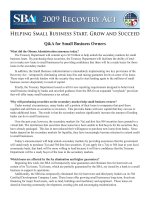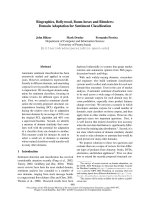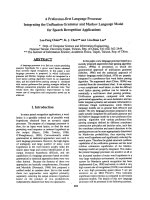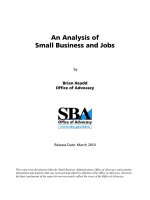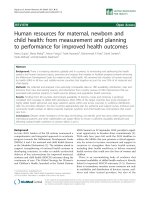HELPING SMALL BUSINESS START, GROW AND SUCCEED: Q&A for Small Business Owners pot
Bạn đang xem bản rút gọn của tài liệu. Xem và tải ngay bản đầy đủ của tài liệu tại đây (408.54 KB, 5 trang )
Q&A for Small Business Owners
What did the Obama Administration announce today?
The Treasury Department will commit up to $15 billion to help unlock the secondary markets for small
business loans. By purchasing these securities, the Treasury Department will facilitate the ability of lend-
ers to make new loans to small businesses by providing condence that there will be a ready buyer for those
loans in the secondary market.
In addition, the Small Business Administration is immediately implementing two key provisions of the
Recovery Act – temporarily eliminating certain loan fees and raising guarantee levels on some of its loans.
These steps will provide lenders with the security they need to start lending again to the millions of small
business owners desperately in need of capital.
Finally, the Treasury Department issued a call for new reporting requirements designed to better track
small business lending by banks and unveiled guidance from the IRS for an expanded “carryback” provision
that will offer many small businesses a tax refund.
Why will purchasing securities on the secondary market help small business owners?
Under normal circumstances, many banks sell a portion of their loans to companies that pool them
together and sell them as securities to investors. This provides banks with new capital that they can use to
make additional loans. The result is that the secondary markets signicantly increase the amount of lending
banks can do to small businesses.
Over the past year, however, the secondary markets for 7(a) and rst lien 504 securities have ground to a
virtual halt. The institutions that securitize these loans have been unable to nd buyers for the securities they
have already packaged. This has in turn reduced their willingness to purchase new loans from banks. Since
banks depend on the secondary markets for liquidity, they have increasingly become reluctant to extend credit
to small businesses.
Today’s announcement will help unlock secondary markets by providing assurances that the government
will stand ready to purchase 7(a) and 504 rst-lien securities. If you apply for a 7(a) or 504 loan at your local
community bank, that bank will be more willing to lend because it will have condence that the Treasury
Department will be a ready buyer of the loan in the secondary markets.
Which loans are affected by the fee elimination and higher guarantees?
Beginning this week, the SBA will temporarily raise guarantees and eliminate fees for borrowers on
certain of its 7(a) loans. 7(a) loans, which are partially guaranteed by the SBA, are issued by a bank to a small
business to support its operations.
Additionally, the SBA has temporarily eliminated fees for borrowers and third party lenders on its 504
Certied Development Company Loans. These loans offer growing small businesses long-term, xed-rate
nancing for major xed assets, such as land, buildings and machinery and equipment. These loans are
aimed at fostering community development, creating jobs and encouraging modernization.
How do I apply for these loans?
Borrowers apply for loans directly with their lending institutions, including banks, credit unions, and
Small Business Lending Companies. The SBA works with thousands of small and large lenders nationwide.
Lenders evaluate loan applications under their lending standards and decide whether to:
a) Make the loan through conventional nancing without a SBA guarantee because the borrower meets
their conventional credit standards;
b) Make the loan with a SBA guarantee if the borrower does not meet conventional standards and is eligible
for SBA programs; or
c) Decline to make the loan.
What kind of businesses typically get SBA-backed loans?
Typical 7(a) borrowers are entrepreneurs looking to start, expand or acquire a small business. In many
cases, the applicant may have a strong business idea, management ability, and sound nancial projections,
but may have a shortfall in collateral to secure a loan or equity to put into the business.
In order to qualify for a SBA 7(a) loan, borrowers must be unable to secure conventional commercial
nancing on reasonable terms and be a “small business” as dened by SBA size standards. In 2008, of the
$18 billion in SBA backed loans, 35% went to start-up businesses, nearly 32% ($5.7 billion) went to minority
owned businesses, and nearly 23% went to women owned businesses. The most frequently nanced
industries in 2008 were services, retail trade, accommodation/food service, construction rms, and
manufacturing.
SBA-backed loans are three to ve times more likely to be made to minority and women owned
businesses than conventional small business loans made by banks, according to a recent study by the Urban
Institute.
Is there a limit on how much I can apply for?
The maximum loan amount for a 7(a) loan is $2 million. For 504 loans, the loan structures and amounts
vary since lenders and borrowers each determine how much equity they are putting into the loan. However,
for the SBA portion of the loan, the maximum loan amount is either $2 million or $4 million, depending on
the purpose of the loan.
For most purposes, the SBA’s maximum guarantee for any borrower remains at $1,500,000, or 75 percent
of a $2 million loan.
How soon can I get a loan to help me and take advantage of these new programs?
You can apply immediately to any SBA participating lender to take advantage of these programs.
• Fees will be reduced for 7(a) loans starting this week.
• Fees will be eliminated for 504 loans beginning this week.
• Microloan intermediaries across the country are providing loans of up to $35,000 right now to start-up,
newly established and growing small businesses.
Lenders will work with the SBA to process and approve these loans. Once we receive a completed loan
package from a lender, the SBA can quickly process applications in just a few days.
U.S. Small Business Administration • Recovery Act: Frequently Asked Questions • 2
Is the elimination of borrower fees permanent and retroactive?
The temporary fee eliminations for 7(a) loans support an overall program level of $8.7 billion, while the
temporary fee eliminations for 504 loans support an overall program level of $3.6 billion. Depending on
loan volume in these programs, the SBA estimates that it will be able to eliminate these fees on loans
approved through approximately December 31, 2009. Fee eliminations will be retroactive for all eligible
loans approved on or after Feb. 17, 2009.
What if I had a 7(a) or 504 loan approved on or after Feb. 17 and already paid the fees? How do I get a
rebate?
SBA is in the process of developing a refund mechanism and expects to be able to begin issuing refunds by
approximately May 1, 2009. If borrowers have already paid lenders for the fees on eligible loans, the lenders
must reimburse the borrowers from the SBA refund.
What kind of savings will I see from the temporary borrower fee elimination?
Fees for a 7(a) loan are based only on the guaranteed portion of the loan and depend on the size of the
loan. The fees range from 2% to 3.75%
For example, a $300,000 loan with a 75% guaranty would have a guarantee fee of 3%. With the
temporary elimination of fees, you would save $6,750.00 ($300,000 x 75% x 3%). Under the new 90%
guaranty your savings would be $8,100 ($300,000 x 90% x 3%).
For a Section 504 loan from a Certied Development Company, the 1.5% application fee that is
frequently charged to small businesses when they apply to the Certied Development Company for a loan
will not be charged. For a typical 504 loan of about $600,000, fee savings would equal about $9,000. In
addition, the SBA charges the rst mortgage lender a fee equal to ½% of the rst mortgage in a Section
504 loan transaction. The SBA will temporarily eliminate that fee as well, further encouraging the rst
mortgage lender to get involved with the development project.
I am a small business owner – what does the 90% guarantee mean to me?
It means that the lender will have less risk and a greater sense of security due to the higher guarantee
percentage and will be more likely to extend credit to your small business.
Can I go to any lender in my area to take advantage of these new programs?
Only lenders who have been approved to participate in SBA lending programs can assist you with an
SBA-guaranteed loan. Contact your local SBA District Ofce to obtain a list of approved participants in your
area.
Follow this link to locate the District Ofce nearest you: />What if I was already turned down by a bank in the past six months? Can I qualify for any of these
new programs?
You are eligible to apply, but you will need to provide updated nancial information that is current within
90 days. Over the past year the nancial position of many individuals and businesses has deteriorated along
with the economy, making some unfortunately no longer creditworthy.
U.S. Small Business Administration • Recovery Act: Frequently Asked Questions • 3
The banks aren’t lending to me. So how do any of the programs the President announced help me?
Revisit your lender and specically ask about the Recovery Act and SBA loans. Many of the provisions
in the Act provide incentives to lenders to encourage them to start lending again to get more dollars in the
hands of the small businesses that need it most. Banks will now have access to more funds and higher
guarantees making it less risky and more attractive to lend to small businesses. Also, you can contact your
local SBA District Ofce to obtain a list of SBA-participating lenders in your area.
I own a small business, and my revenue has gone down. The equity in my house has declined and I
don’t have any more collateral to pledge. How do the President’s programs help me?
SBA does not have a specic level of collateral that must be pledged. If your business is viable and you
have pledged all of your available business and personal assets, a lender may consider making a loan to you
with an SBA guarantee.
Additionally, as part of the Recovery Act, SBA is developing a new program to help viable businesses
with immediate nancial hardships with a short term loan that will help them make payments on their
existing loans. We are working hard to get this program up and running as quickly as possible.
The Recovery Act includes other initiatives to help small business owners, including targeted tax relief
for small business owners, allowing “carryback” of losses from this year for up to the previous ve years;
reducing the estimated tax payments a small business makes to the IRS from 110 percent to 90 percent; and
providing the ability to write off up to $250,000 of certain investments made in your small business.
I have only been in business for two years and don’t have three years of nancial statements or
business history. Can I get a loan?
Yes, you may qualify for a loan. SBA loan guarantee programs are available to start-up, newly
established and growing businesses. You will need to provide whatever nancial information you have
available and will also be asked to furnish nancial projections with assumptions to support your loan
request.
I got laid off from my job. Now, I want to start a new business, building on my prior skills. I have a
good business plan and am working with an accountant and an advisor. Can I get a loan from any of
these new programs?
SBA loan programs are available to start-up businesses as well as those that are already established.
All applicants must meet certain SBA eligibility and credit requirements. In general, you must be organized
for prot, meet SBA specic size standards, and be unable to obtain funding on reasonable terms through
traditional lending channels.
When applying for a loan, you must prepare a written loan proposal or business plan. The proposal should
outline your business strategy over the next several years and briey explain who you are, your business
background, the nature of your business, the amount and purpose of your loan request, your requested terms
of repayment, how the funds will benet your business, and how you will repay the loan.
SBA has a host of resource partners ( that can assist you
in developing your plan, as well as online training resources through the Small Business Training Network
/>U.S. Small Business Administration • Recovery Act: Frequently Asked Questions • 4
I need working capital now to buy inventory and to make payroll. How long will it take to get a loan?
How much can I apply for?
You can apply for a loan by talking to a local SBA participating lender today. Once SBA receives a com-
plete application package from your lender, SBA typically responds to the lender within a few business days.
SBA loan programs are available for most sound business purposes including working capital, machinery and
equipment, furniture and xtures, land and building (including purchase, renovation and new construction),
leasehold improvements, and debt renancing (under special conditions). The maximum loan size under
SBA’s 7(a) loan program is $2,000,000, although some programs have specic maximums that are lower.
I operate my business from home – does that matter? Can I qualify for a loan?
No, it does not matter. A home-based business must still meet our standard eligibility and credit criteria
for all businesses. If you meet all eligibility and credit criteria, you can apply for a loan.
The President mentioned that the $15 billion from the Treasury would primarily be focused on buying
loans and freeing up lending for community banks, credit unions and other small lenders. Why?
Community banks, credit unions and other small lenders account for about 40 percent of all SBA-backed
loans. Unclogging the secondary market for these local, small lenders will help them provide greater access
to capital for the small businesses and entrepreneurs in their communities. While unclogging the secondary
market is aimed at providing a funding source for smaller lenders, large lenders may also use the secondary
market as a source of liquidity.
What other provisions are in the Recovery Act beyond fee elimination and higher guarantees, and
when will they be implemented?
The additional provisions in the Recovery Act include:
• Microloan Expansion: Provides extra funding for loans and technical assistance to SBA backed micr
lenders
• ARC Stabilization Loans: Offers 100% guaranteed deferred payment of loans up to $35,000 to help
viable small businesses facing immediate economic hardship make payments on existing qualifying loans
• Expanded 504 Renancing Project: Allows borrows to renance an existing eligible loan as part of a new
504 small business expansion project.
• Surety Bond Program Expansion: Allows more small businesses to compete for contracts by raising the
maximum amount for contracts that qualify for SBA surety bonds to $5 million and up to $10 million for
certain contracts.
• SBIC Program Expansion: Increases the maximum levels of funding that SBA can provide to SBICs.
• Secondary Market Guarantee for 504 First Mortgages: Provides liquidity to lenders by allowing SBA to
guarantee 504 rst mortgage pools sold into the secondary market.
• 7(a) Secondary Market Lending Authority: Increases liquidity in the secondary market for SBA loans by
directly lending money to brokers to purchase SBA 7(a) loans.
SBA is working hard to implement these provisions with the goal of having the broadest impact on
small businesses as rapidly and effectively as possible. Implementation will begin as soon as the rules and
regulations are published in the Federal Register.
U.S. Small Business Administration • Recovery Act: Frequently Asked Questions • 5


